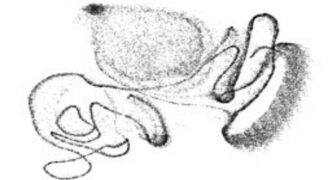
Credit: Lois lab
Every year, more than 795,000 people experience having a stroke, often resulting in brain damage that impairs their ability to speak, walk, or perform tasks. Fortunately, in many cases, these abilities can be regained through physical therapy. With practice, our brains have remarkable abilities to rewire and repair themselves after damage.
Researchers in the laboratory of Carlos Lois, research professor of biology at Caltech, use small birds called zebra finches to study how brains rewire themselves to regain essential functionality after damage. In a new paper, they discover that zebra finches can reacquire the ability to sing after brain damage similar to stroke victims—but without practice.
“Imagine a pianist who suffers some kind of brain damage and is unable to play the piano,” Lois says. “But one day, they wake up and can suddenly play again. Somehow, their brain was able to rewire itself and access the ability to play without any practice. This is what we found in songbirds.”
The new study appears in the journal Nature Neuroscience on April 29.
Zebra finches are not born with their unique individual songs; they learn their song by listening to their father sing, and they continue to sing that same song for their whole lives. While they have an innate predisposition to learn songs, zebra finches will not learn the song of another species, even if hearing it as a young bird. In other words, the finch brain is programmed to pay attention to and copy a particular species-specific set of sounds.
The new study examined adult male finches who had already learned their own songs. The researchers focused on the region of the brain that encodes the ability to sing, called the high vocal center, or HVC. This area is critical for the bird’s production of its song, controlling the syllables of the song and the order they are produced in. In the study, the team genetically silenced about 70 percent of neurons in the HVC, leaving all other neurons in the bird’s brain untouched. When the animals tried to sing, their songs were dramatically degraded and sounded nothing like the original.
Once it was confirmed that the song was fully degraded, the birds were silent for 10 days. After this time, the zebra finches were allowed to sing again, and they suddenly regained the ability to sing their songs correctly, as if nothing had happened. Importantly, during the silent period, the birds were not hearing any other songs or sounds, meaning that they were not relearning a song—rather, the birds were able to rewire their own brains to be able to access the memory of their original song, using only the remaining 30 percent of neurons in the HVC.
The researchers hypothesize that although the animals did not sing while they were awake, they may have been “dreaming” their songs while asleep, enabling their brains to rewire themselves. In the same way that our dreams mimic our experiences when we are awake, bird brains also experience “sleep replay.” The team theorizes that the brain is essentially fixing itself during this so-called offline activity.
Next, the researchers aim to image finch brain activity following the genetic lesion while the birds are sleeping. This will allow the team to observe patterns of neuronal activity in the HVC and determine if the region is rewiring itself during sleep.
The unchanging nature of zebra finches’ songs over long periods of time makes them a powerful model system for understanding how the brain produces behavior. Because the song is identical every time they sing it, researchers can identify precise correlations between brain activity and behavior, and detect minute differences. Other model systems, such as mice, have much more variation in their behavior (for example, a mouse does not always navigate a maze in the exact same way).
Many questions remain about the brain that Lois hopes to answer with finches as a model system.
“The original song is stored somewhere in the brain, and the animals somehow manage to access it and use this information to rewire themselves,” Lois says. “No one really knows how we store memories in the brain or how we access them. There is so much that still is totally unknown about how the brain functions.”
The paper is titled “Unsupervised restoration of a complex learned behavior after large-scale neuronal perturbation.” The study’s lead authors are Bo Wang, senior postdoctoral scholar research associate in biology and biological engineering; former graduate student Zsofia Torok (PhD ’23); and Alison Duffy of the University of Washington. Additional Caltech co-authors are former research technician Shelyn Wongso and former postdoctoral scholar Tarciso Velho. Other co-authors are David Bell and Adrienne Fairhall of the University of Washington. Funding was provided by the National Institutes of Health. Carlos Lois is an affiliated faculty member with the Tianqiao and Chrissy Chen Institute for Neuroscience at Caltech.














 1 comment
1 comment


